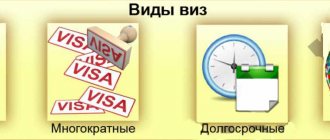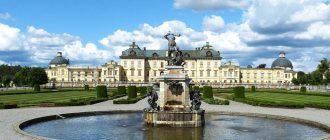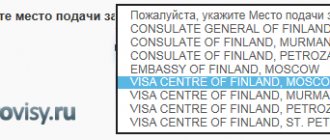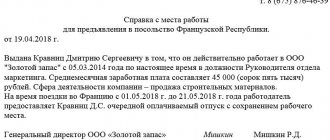Sweden is one of the most attractive European countries to live in. It ranks seventh in the world ranking, which assesses the level of human development and well-being. What is the secret of success? In the competent organization of all social institutions, including education. This is what we will talk about in more detail in our article.
From it you will learn how education works in Sweden, how it differs from ours, and also get an answer to the question: is there free education in Sweden for Russians? Ready? Then let's go!
Do you want to receive even more interesting and useful articles? Subscribe to our Telegram channel. And don’t forget to follow the company’s promotions and discounts!
General features of the education system in Sweden
The education system in Sweden is one of the oldest in Europe. Thus, the first church school appeared in the Swedish city of Lund already in the 11th century, and by the end of the Middle Ages there were more than 40 such educational centers. Nowadays, the Swedish education system is considered effective and very progressive, and diplomas from higher educational institutions provide a significant advantage when looking for work abroad and a confident start to career growth.
What features of studying in Sweden make it so attractive:
- Not only citizens of the country, but also immigrants and their children can receive compulsory free school education in Sweden;
- You can study for free in Sweden until you are 54 years old (for citizens only);
- You can find a job with a diploma from a Swedish university in any country in Europe and abroad - there will be no problems with document recognition, since Sweden is part of the Bologna education system;
- there are no strict rules in schools and universities, the emphasis is on informal relationships between teachers and students;
- emphasis is placed on developing high tolerance and instilling European values;
- each university develops relevant and effective programs - they are independent of state policy in the field of education;
- the development of creative abilities and a creative approach is encouraged;
- learning is applied in practice - universities work closely with enterprises where students can gain real work experience;
- There are many English-language programs at universities;
- language schools operate for foreign students;
- there is a system of grants and scholarships that even a foreign student can receive;
- students can freely work part-time after studying without additional permits;
- The Ministry of Education strictly monitors compliance with high standards of education - it is not surprising that the majority of Nobel laureates are graduates of Swedish universities.
The Nobel Prize is a prestigious award given annually for achievements in the fields of physics, chemistry, physiology and medicine, literature and contributions to peace issues. The awards ceremony for the first four takes place at the Royal Family Palace in Sweden. And the latter is awarded in Norway.
Nobel Prize. Award ceremony.
Programs and levels of training
Higher education institutions are divided into: universities and colleges attached to them. Upon completion, students graduate with a bachelor's degree. Admission to a bachelor's degree is based on complete secondary education.
The Swedish university has the following programs:
- Master's degree - in-depth study of subjects;
- Bachelor's degree - after graduating from high school;
- postgraduate studies, doctoral studies - preparation for defending a dissertation or research work.
To obtain a degree (master's or bachelor's), you must complete courses in academic disciplines. Every semester, students take them on a selected project.
Also in Sweden they offer additional education. For example, trainings and seminars. These are short-term programs, after which graduation is not planned.
Education system in Sweden: briefly
What levels of education exist in Sweden? To figure it out, we have prepared a short and clear table:
| Preschool education in Sweden | Schooling in Sweden | Higher education in Sweden (Bologna education system) |
| Kindergartens (from 1 year to 5 years). | Compulsory secondary education (9 years) | Universities |
| Open kindergartens, or “day mother”. | Primary school (grades 1-3). | Bachelor's degree. |
| Primary and preparatory classes (from 6 years old). | Intermediate school (grades 4-6). | Master's degree. |
| High school (grades 7-9). | Doctoral studies. | |
| Optional basic general education (3 years) | University colleges (institutes) | |
| Gymnasium (up to 20 years old). | Bachelor's degree. | |
| Higher public schools for adults (150 schools). | ||
| Komvux - municipal schools for adults. |
Inclusive education is very developed in Sweden. Special educational programs are being developed for special children, conditions are created for attending lessons in regular classes, and integrated learning methods are actively used. Thanks to this policy, 80% of people with special needs receive secondary education certificates and feel like full-fledged members of society.
Preschool
The first level of the education system in Sweden is kindergartens, which accept children from the age of one year. Attending preschool is not compulsory, but most young Swedes enjoy spending time there. In the company of teachers, children play, go on excursions to libraries, museums, and walks in parks. For one teacher there are from five to ten students, so no one is left without attention.
If parents deem it necessary, at the age of six, children can begin classes in a preparatory class, where they will not only have fun, but also begin to learn literacy, numeracy, and the basics of knowledge about nature.
Kindergartens are intended for children whose parents study or work, so the municipality is obliged to provide the child with a place in the nearest kindergarten for at least 15 hours a week. No exceptions are made for children with disabilities: special pupils spend time in the same group with other children, but under the supervision of specially appointed preschool teacher assistants.
The bulk of kindergartens are supervised by the state, so for Swedish citizens, paying for preschool services is not burdensome.
Primary education system in Sweden
The main difference between preschool education in Sweden and other countries is that they believe that a child should have a fun and carefree childhood. Therefore, in kindergartens, children learn to communicate, play and spend a lot of time in nature. You can bring your child to preschool as early as one year of age. The following types of kindergartens are distinguished by type:
- kindergartens;
- open kindergartens, or “day mother”;
- elementary and preparatory classes.
Kindergartens
In kindergartens in Sweden, they mainly develop the child’s communication abilities, teach him to express himself and his emotions, and find a common language with other children. Kindergartens in the country are paid, but there is a flexible pricing system that depends on the time of visit, the number of children in the family and the parents’ salary:
- a child can attend kindergarten free of charge for no more than 15 hours a week (three hours a day);
- if there are four or more children in a family, they also have the right to free admission to kindergartens;
- if there is only one child in the family, parents pay 3% of monthly income, but not more than 130 euros;
- if there are two children - 2%, but not more than 86 euros;
- if there are three children - 1%, but not more than 43 euros.
Open kindergartens, or “day mother”
“Day Mom” is a home-type kindergarten that is organized by young mothers in their home. They can take an additional 3 to 5 children and teach them independently. Conditions for payment and time of stay of the child in such a kindergarten are negotiated separately.
Zero and preparatory classes
In order to enroll in a Swedish school, children must be able to read, write and do math. Kindergartens do not provide such training. For this purpose, there are special elementary and preparatory classes in which children from the age of six are enrolled. The guys study for three hours a day, and the classes are relaxed and playful.
In Swedish kindergartens, children spend most of their time outside
Overview of the Swedish education system
Kindergarten
In many developed countries, children are fed education from an early age. In still undeveloped heads, parents often try to give too much information. Sweden is trying to move away from this standard. Kindergartens here operate according to the principle: “A child should have a childhood.”
In fact, they are not taught anything. The child rests all day long, spends a lot of time in the fresh air and earns authority among his peers. As a rule, there are not too many children in the group; the teacher carefully monitors them. When the weather is good, the group is constantly outside and even sleeps there.
There are many educational institutions in each region. However, they are paid, and there is a system of discounts for large families. The first child goes at full price, the second - with a 50% discount, the third - free.
School education
At the age of 6, any child can go to preschool for free. There they are prepared for further education at school, taught to read and write, and taught the basics of discipline in class. After this, junior, middle and high school begins.
Most classes are held in group mode. The teacher tries to give all children equal opportunities, finding an individual approach to each. After the lesson, if one of the students excels, they talk to him face to face. No one is scolded or praised in public. Until the 6th grade, children are not given any grades.
The main subjects are language, home economics, social studies, and natural history.
From the age of 7, students regularly watch a children's news program and discuss events happening in the world. From 3rd grade a language is added. Moving to secondary school, the child gets the opportunity to independently choose subjects and create a personal schedule.
Specialized secondary
Secondary specialized education in Sweden is based on the principle of unification. Once upon a time, there were many gymnasiums in the country that provided primary vocational education. They belonged to different individuals, studied under different programs and had no connections with each other.
However, in 1975, the government made a strong-willed decision by uniting all higher schools into one gymnasium. Any young person under the age of 20 can study there. Education is free and available to every citizen of the state. Russians who have received citizenship can also apply for a similar benefit.
There are currently about 16 different programs for students in the country. Of these, only 2 are aimed at continuing the course at the university. The remaining 14 are needed to master a working profession. Such students either change their major over time or look for a job.
Higher
Any citizen or migrant with official permission has the right to free education at a higher education institution. Moreover, if you were able to pass through a difficult competition, you will be awarded a scholarship of 800 euros per month.
To begin with, people enroll in a bachelor's degree, where they traditionally study for 4 years. It is believed that obtaining a first degree is just a step on the path to education. Students become familiar with their specialty and learn the basics. Most students work in parallel with their studies: the law does not prohibit this.
After this, any person has the right to transfer to a master’s program, which lasts for 2 years. All this time, they are already studying their chosen profession in depth, becoming a real specialist. If this is not enough, you can go to graduate school. This type of training already counts as research work.
Secondary education in Sweden
Secondary education in Sweden has its own specifics.
- The training is absolutely free.
- It is available not only to citizens of the country, but also to all other persons, regardless of origin, age, gender and religion.
- Studying in Sweden gives the right to obtain a residence permit, and in the future Swedish citizenship.
Secondary education in Sweden consists of two levels:
- compulsory (secondary schools);
- optional, higher secondary (gymnasium).
Education in Swedish kindergartens and schools is based on the principle of conformity with nature. This pedagogical approach takes into account the individual characteristics of the student, which are inherent in him by nature, and helps to reveal the child’s inner talents.
Compulsory secondary education
The duration of compulsory free secondary education in Sweden is nine years:
- primary school (grades 1-3);
- middle school (grades 4-6);
- high school (grades 7-9).
In Sweden, in addition to municipal free schools, there are independent and private ones. Their training is paid. But before enrolling a child in such a school, it is necessary to check two things: the presence of an official license and compliance of the training program with the requirements of the Ministry of Education. How much does it cost to study at such schools in Sweden? On average it can be 9,500 euros per year.
To enter a municipal school and then move to another level, students take exams. However, grades begin to be given only from the sixth grade of intermediate school. To do this, use letter marks rather than numbers:
- A - highest score;
- F - passed.
After completing nine grades of secondary school, children have two options. They can pick up their certificate and go look for work or apply to a gymnasium and receive a complete secondary education.
By the way! Our readers now have a 10% discount on any type of work.
Non-compulsory secondary education: gymnasiums
Education in gymnasiums is not compulsory, but many school leavers decide to continue their education. Young people under 20 years old can enroll in them. For older people, other training options are available. Education itself at the highest level lasts three years and provides in-depth training in one of 18 programs:
- 12 programs are narrow-profile areas of specialist training;
- 6 programs - direct preparation of high school students for entry into higher education institutions: universities and colleges.
It is worth distinguishing Swedish gymnasiums from Russian ones. In Sweden, these are vocational educational institutions that train specialists, and not specialized high schools like ours. By the way, training there is free for Russians who have received a residence permit in Sweden.
Additional education in Sweden: higher public and municipal schools
But what should you do if yesterday’s student took a long gap year and did not have time to apply to the gymnasium until the age of 20? For them, as for other Swedish citizens, training is provided in two areas:
- higher public schools;
- Komvux - municipal schools for adults.
An education diploma in Sweden opens the door to any European company
Higher public schools
There are 150 of these specialized schools for adults in Sweden, offering a variety of vocational courses and training programs.
Higher public school programs are used to adapt immigrants to a new country. Thanks to this initiative, foreigners can not only learn Swedish, but also obtain a specialty.
Komvux
Komvuks are municipal schools for adults that provide complete secondary education. All the same subjects are taught here as in Swedish gymnasiums. At the end of the training, the graduate receives a gymnasium certificate and can enter the university.
Education in public schools and colleges is practically free: you only have to pay for textbooks and stationery.
Student accommodation in Sweden
The average cost of training in a specialty in the state is about 15 thousand US dollars per year. If you do not have such a sum, try to get into one of the few international programs. At the same time, training students in creative specialties costs them a large sum.
Most students must purchase appropriate literature themselves. On average, you will have to pay about $1,000 per month for a set of textbooks for the year. This list also includes various consumables. But the university provides some literature for free.
To obtain a student visa and residence permit, you must always have $800 per month in your bank account. According to the government, this money is enough for a normal life.
Higher education system in Sweden
Higher education in Sweden can be obtained at universities and university colleges (institutes). There are more than 50 of them in the country.
How to figure out which university or college to choose for admission? There are several options:
- go to the website of each university;
- view information on the website of the State Administration of Higher Education.
This website contains data for each educational institution.
How is a university different from a college in Sweden? The university provides the opportunity to enroll in master's and doctoral studies and receive an academic degree, while college only provides a bachelor's degree.
Since the higher education system in Sweden complies with the Bologna process, universities offer three educational levels:
- bachelor's degree;
- master's degree;
- doctoral studies
Until 2010, foreigners could receive not only general but also higher education in Sweden for free. Now it is only available to Swedes, residents of the EU and Switzerland. However, despite the removal of preferential conditions, the cost of studying in Sweden is still lower than in other European countries.
What language should I learn: Swedish or English?
It is not at all necessary to learn Swedish to obtain higher education in the country: many universities in Sweden offer a number of programs in English.
To study in English, the admissions committee must provide TOEFL test results (not lower than 90) or IELTS (not lower than 6.5). Language requirements for the minimum score can vary greatly depending on the ranking of the university, specialty, and level of study, so it is worth contacting the website of each university of interest to clarify the information.
If you speak Swedish, you will need to take the TISUS test. The Swedish Embassy, as well as a number of educational institutions in the country, accept the exam. Its cost is about 9.8 thousand rubles. The good news is that there is no test grading scale as such; there are only two options: you can either pass the test or fail it.
Best Universities in Sweden
Swedish universities consistently occupy high places in educational rankings. For 2021, the most successful were:
Karolinska University. He specializes in medical sciences. Many medical scientists who received Nobel Prizes in physiology and medicine are graduates of Karolinska University.
Lund University. It is considered one of the best universities in Scandinavia and trains specialists in various specialties: politics, medicine, biology, chemistry, geography, linguistics, communications and others.
Uppsala University. One of the oldest universities in the country, which graduates specialists in medicine, pharmacology, law, social sciences, and so on.
Stockholm University. The largest university in the country, which gathers famous scientists and researchers and is rightfully considered the center of science in Scandinavia.
University of Gothenburg. The same applies to large universities in the country. Specializes in finance, information technology, medicine, economics, law, fine arts, design.
Karolinska University
The most famous Swedish universities
The most popular universities among Swedes and foreigners themselves include:
- Stockholm University. It offers a wide range of programs and collaborates with many universities around the world.
- Swedish University of Agricultural Sciences. The university is considered one of the best in the field of agriculture. A popular trend is the creation of an environmentally friendly living environment.
- University of Technology. Offers education not only in technical, but also in humanitarian areas.
- Umio University (Umeå universitet). Offers more than 1,000 different programs, some of which are presented in English .
- Lund University . The university is the largest research center.
- University of Karlstad (Karlstads universitet). The university offers several dozen educational programs.
- universitet . It provides education in a large number of areas and is the oldest university in the kingdom.
Higher education in Sweden for Russians
Education in Sweden for Russians does not lose its attractiveness despite the fact that it is no longer free. The cost of such training is still less than in other countries, and the quality of education is one of the highest in the world.
How to enter a Swedish university
You can enroll in Swedish universities immediately after school or while studying at university. Russian students who want to get higher education in Sweden have two options:
- participate in academic exchange programs;
- go to university on your own.
To participate in a bilateral exchange program, you need to find out from the dean’s office whether such an opportunity exists and fulfill the conditions.
This will not only allow you to spend several semesters at a Swedish university, but also get to know the higher education system from the inside. Another advantage of exchange programs is that they offer a free education format even for a bachelor’s degree. If exchange programs are not provided, you can always enroll in a Swedish university on your own. And now we will tell you what documents you need to provide for this.
Documents for admission
The package of documents required for admission depends on the university and the program the student is enrolling in. For a bachelor's degree the following set is required:
- a copy of the school certificate of completion of secondary school - its translation with notarization;
- notarized translation of a copy of the diploma enclosure with final grades;
- certificates confirming knowledge of a foreign language: for English - TOEFL or IELTS, for Swedish - TISUS or SLTAR;
- a voluminous letter of motivation in which it is necessary to justify the choice of the university and the desire to study there;
- letters of recommendation from teachers from school or university;
- copy of international passport;
- receipt of payment of the fee (92 euros);
- a copy of the grade book and its translation (if you are entering after the first year of university).
To enroll in a master's program in Sweden, you must provide the following package of documents:
- translated and certified translations of copies of higher education diplomas (the specialty in the diploma must correspond to the one for which the student is applying);
- a copy of the grade book and its translation;
- letters of recommendation from university teachers;
- certificates confirming knowledge of a foreign language: for English - TOEFL or IELTS, for Swedish - TISUS or SLTAR;
- copy of the international passport;
- receipt of payment of the fee (92 euros).
To enroll in doctoral studies in Sweden you need to collect:
- translated and certified translations of copies of higher education diplomas;
- confirmation of work experience in the specialty if the specialization profiles coincide;
- translations into English and Swedish of your scientific works (master's thesis, scientific articles, research abstracts, etc.).
- certificates confirming knowledge of a foreign language: for English - TOEFL or IELTS, for Swedish - TISUS or SLTAR;
- copy of the international passport;
- receipt of payment of the fee (92 euros).
Procedure for submitting documents
To enter a Swedish university, you do not need to take entrance exams. You must register on a special website and submit documents correctly. This can be done twice a year:
- winter: from December 1 to December 16 (for the autumn semester);
- summer: from June 1 to August 15 (for the spring semester).
You can submit documents later than the specified dates, but then the chances of admission will be small.
Universities consider such applicants last if there are places left. Carefully read the terms and conditions on the site and follow the instructions provided. All that remains for you is to wait for a response from the chosen university with a positive or negative decision.
Where can Russian citizens study in Sweden?
Studying in Sweden is quite accessible for Russian citizens, but requires knowledge of languages - English and Swedish.
It is advisable to send young children (especially those born in Sweden) to a local kindergarten (if their parents have a residence permit) - here they will adapt faster, master the Swedish language and will be able to study at school in the future. Older children should be sent to school. If parents do not plan to live in Sweden on a permanent basis, children can be sent to Russian children's educational institutions in Gothenburg and Stockholm - for example, to a secondary school at the Russian Embassy in Sweden.
This school opened in 1995, is licensed, accredited and provides training according to Russian educational standards and curriculum for primary, secondary and secondary schools. Children aged six and a half years and older are admitted to school (at the request of parents, admission at an earlier age is possible). Since 2013, the school at the Russian Embassy in Sweden has become an official educational specialized unit of the Russian Embassy.
Education of children from the Russian Federation (not permanently residing in Sweden) in Swedish public schools is possible for one academic year, subject to their participation in a special exchange program for schoolchildren aged 14 to 17 years.
To study for a year at a Swedish gymnasium, the applicant must have a good knowledge of English, have good grades and be sociable. Accommodation is in a Swedish family of the same age. To participate in the program you need to pay about 6 thousand euros per year.
It is also possible to study in private and international schools. Tuition fees are set by the individual educational institution.
Obtaining higher education in Sweden has recently become increasingly attractive for Russian citizens. The most desirable universities in Sweden for Russians are universities in Stockholm, Uppsala, and Lund. The rules for admission to universities are the same for everyone - it all depends on the average score of the certificate and the deadline for submitting documents.
Scholarships and grants for training
We found out how much it costs to study in Sweden. Now let's find out how you can get a scholarship to reduce your fees as much as possible.
The grant system is available only to applicants entering master's or doctoral studies. International students applying to undergraduate programs are not eligible for scholarships or grants. There are other opportunities for them: student loans and part-time work after studying at university.
Studying at a Swedish university is not only a quality education, but also communication with different people
Grants for studying in Sweden
In Sweden there are a number of grant programs in which not only citizens, but also foreigners can participate.
- Swedish University Scholarship Fund. This is 500 grants that the Swedish government issues annually for the education of foreign students.
- Erasmus Mundus. This program brings together a number of European universities and facilitates two-way exchange so that young people can receive education in different countries.
- Scholarship programs of Swedish universities themselves.
A scholarship or grant can cover from 15 to 100% of a student’s total expenses for studying at a Swedish university.
How to get a scholarship or grant for study
To become the proud winner of a scholarship, you must do the following:
- clarify the conditions of the program;
- submit documents confirming high academic performance;
- write an application addressed to the administration if we are talking about a university scholarship;
- fulfill the terms of the program, if we are talking about a grant.
In this case, the student must stay in the country for at least two years and not participate in other scholarship programs.
Education in Sweden is an excellent investment in your confident and promising future! So look for student exchange programs, study well, and if you need help writing any type of work, contact the student service!
Cost of studying in Sweden
How much does it cost to study in Sweden is an important question for any student. Studying at a public school will cost a Russian citizen 6,000 €. In private institutions the price will be higher. The average cost of studying at a university is from 10,500 € to 38,400 €. The student will also have to pay:
- Housing . Universities provide dormitories. Monthly cost of living – from 240 € to 470 €. However, there are not always enough places in dormitories for everyone. A student can live in special student apartments and pay up to 420 € per month for them. Renting a one-room apartment costs up to 1000 € (in the center of Stockholm);
- Nutrition . Lunch in an inexpensive cafe will cost 9 €. Dinner at a restaurant can cost several times more. To save money, you need to buy food in the supermarket and cook it yourself. Food costs will be up to 200 € per month;
- Transport . In order to save money, you need to buy a travel ticket for 73 €;
- Other expenses . Up to 100 € per month is spent on visiting attractions, cinemas and buying basic necessities.
How to enter a university in Sweden
Any foreigner can apply to study at a Swedish university. But, as a rule, not everyone does. And it’s a shame when the reason for refusal is technical errors when submitting applications or sending documents. Therefore, the process of entering a university in Sweden and collecting the necessary information should be taken as seriously as possible.
Requirements for international students may vary depending on the institution. But everyone has the same general criteria.
General requirements for foreigners to enter a university in Sweden
- Certificate of complete secondary education plus an application with grades . Depending on the country, the requirements may be supplemented. For example, Ukrainians need to attach the result of the External Test, and Russians need to submit the Unified State Examination. Moreover, it is very important to have excellent academic performance, because there are generally no entrance exams - this will be decisive for admission.
- Knowledge of English, confirmed by a certificate.
- IELTS. The overall score is at least 6.5.
TOEFL IBT. Paper carrier. The total score is not lower than 575, incl. written test score of at least 4.5.
- Internet version. The overall score is at least 90, including at least 20 in the written test.
- Cambridge. A minimum of 90 points is required.
- If you plan to enroll in a master's program or simply have a diploma from a university in another country, which can significantly increase your chances of being accepted into a bachelor's degree program, you must go through the qualification recognition procedure . This is done on the official website of the Swedish Council of Higher Education.
- Documents must be translated into Swedish or English.
Sending applications for admission to a Swedish university is carried out through a special portal universityadmissions.se. Here you can select the university and study program you are interested in, as well as learn more about the requirements for international students.
You are allowed to apply for 8 programs simultaneously. The registration fee is SEK 900 (approx. EUR 85). Particular attention should be paid to application deadlines. Most universities in Sweden finish accepting applications for the fall semester until January 15th .
Individual universities in Sweden set their own conditions for students from abroad. For example, some technical courses may require additional tests in mathematics or, conversely, less advanced knowledge of the English language. In any case, all the necessary information should be found on the website of a specific university.
Once the application is approved, you must confirm your intention to study at a Swedish university and immediately begin applying for a residence permit in Sweden. This procedure is mandatory for foreign students from non-EU countries planning to study for more than 3 months. The application is submitted through the website of the Swedish Migration Agency.
Basic requirements for obtaining a residence permit in Sweden for the purpose of study
- Full-time enrollment at an accredited Swedish university.
- Initial tuition fee.
- Valid passport.
- Financial security sufficient to live in Sweden while studying. The amount is 8370 CZK per month (about 795 EUR).
- Submitting an application and paying the registration fee - 1500 CZK (about 140 euros).
Grants and scholarships
Foreigners have the right to apply for competitions. Sometimes winners are paid for participation in the program in full. On average, the scholarship covers 25–50% of expenses. To participate in grants, you must meet a number of criteria:
- live in Sweden for more than 2 years;
- do not have a residence permit or work permit;
- do not participate in other scholarship programs.
Beneficial grants with subsequent employment are provided to those pursuing doctoral studies. Scientific personnel are in great demand in Sweden.
Choosing a school in Sweden
Among the best schools in Sweden is the boarding school Lundsbergs skola. Here the traditional approach to education is combined with modern pedagogy. Even royalty studied at this school.
Reviews about studying in Sweden are mostly positive. Here's what children from Russia say:
- friendly relations with teachers;
- the attitude of adults towards each student as an equal;
- more freedom and independence than in a Russian school;
- a lot of research work.
“The Screams of Flogsta”, or How Studying Works at Swedish Universities
Higher education in Sweden in general is not very different from Europe, since the Bologna system equalized everyone. However, there are also some peculiarities here that will seem unusual to those who come to Swedish universities from Russia.
Several Russians - students and teachers - told Yana Pchelintseva about their experience of higher education in Sweden.
The text continues the joint project COLTA.RU with the official website of Sweden in Russian Ru.Sweden.Se - “For example, Sweden.”
Go to university without haste
In Russia, entering university immediately after school is a natural continuation of education. But for Swedes this is just atypical. Most graduates of gymnasiums, that is, institutions of secondary education, are not in a hurry to go to university, but prefer instead to spend several years self-determination.
— There are very few twenty-year-old students in Sweden, we don’t have them at all at our institute, everyone is older. Master's (master's degree according to the Bologna system) here is closer to 30, and the average age of graduate students, those preparing to receive a PhD, is already 35–40 years old, says Vasily Sitnikov, a graduate student at the Institute of Architecture in Stockholm. — After school, everyone wants to travel and see the world. Many live in another country, work part-time, take short courses, and volunteer. And then they come back and at some point go to university. If they deem it necessary.
Thus, Swedes choose to study consciously and then also consciously realize this opportunity. And, of course, no one undertakes to forcibly guide these adults at the university. Everything is considered worthy of testing and testing. Behind everything lies only the interest of the student himself, and not the teacher. There is an atmosphere of absolute equality at universities. Everyone calls each other by name and first name. This only emphasizes fundamental equality: here everyone will be heard, everyone’s position will be taken into account.
System
Sweden joined the Bologna education system, which includes two levels of training, in 2007. Here you get a bachelor’s degree in three years, a master’s degree in a year or two: it all depends on the university and the specific program. For those who want to build a career as a researcher or university teacher, there is a doctorate - a dissertation in Sweden takes four years to write, and during this time the doctoral student receives a salary, not a stipend.
It all happens like this.
— When entering a university, students first enroll in a training program - this moment is comparable to choosing a faculty in Russia. At the bachelor's level, they attend three compulsory six-month cycles in their specialty. And in the remaining three semesters, they already receive some freedom: the student takes only those courses that are needed for his future graduation project and career, says Yulia Gradskova, a researcher and teacher at Stockholm University.
However, it is not at all necessary to choose only courses offered by your department or even your university. In Sweden there is a unified digital database of courses for all universities. In it you can find out the content of the course, the formal requirements, the skills required for such training, and the number of “credits” the student will receive (this is somewhat similar to our “credit units”: for different levels of study you need to create programs for a certain number of points). But even if a student meets all the formal requirements, he may not be accepted into the course due to high demand, but may only be put “in a queue.” You can apply for any number of course modules, the most important thing is to eventually gain the required number of “credits”.
— By the beginning of the semester, you must decide which courses you are taking. Let's say I'm studying on a grant from the Swedish Institute, and this semester I need to take four courses, because that's how much the grant pays for. In different universities and at different stages, the number of modules varies: somewhere there are more, somewhere less, it all depends on the “cost” of the module (it can be 15 “credits”, or maybe 30). Your department at the university sometimes recommends that you take one or two courses in your direct specialty, and choose the rest yourself,” says Daria Sofina, a master’s student at Stockholm University.
— Everything is based on the student’s interest. They will gladly give you all possible knowledge, but you need to understand what you need. Sometimes, especially for rare and unpopular specialties where there is no flow of students, this turns into a problem, because many cannot decide what to do with their studies, says Masha Sandomirskaya, a graduate of Lund University.
At the same time, from the point of view of a Russian student, studying at a Swedish university may seem like a freebie. There are not so many classroom activities - lectures and seminars. It happens that a student comes to university only two or three times a week. We are accustomed to the idea that “if you sit in classes, you are free,” because classes can last from the morning until at least lunch, or even until the evening: educational standards in Russia provide for a significant classroom load.
In Sweden everything is slightly different. Students here must also spend 40 hours a week studying, but mainly in the form of independent or group work: reading, writing essays, joint research and educational projects.
“Surely bachelors have more lectures than master’s students, but we had very few of them,” notes Daria. — At the same time, it’s convenient that the courses come together with seminars: you don’t have to lecture for two months on all courses, and then you have to prepare for seminars and tests in all areas within a week. A couple of lectures and immediately seminars, in different formats. Group work is highly valued: for example, we are given different roles in the team, and we solve problems together. This helps a lot in understanding the material.
Think yourself
For Swedes, all this is not surprising: the country has a real cult of collectivity. Many decisions are made here jointly, and therefore discussed collectively. Hence the love for meetings, discussions, and teamwork among both students and university staff.
Independent studies are concentrated in libraries. These are real centers of knowledge where students go with pleasure. For Swedish students, sitting in the library is a completely normal pastime, especially for humanities majors. For each course you will be offered a list of literature from which you need to read a certain number of pages.
By the way, here too the student has a choice: you can think for yourself which sources to focus on, make changes to the proposed list, or offer your own sources. What is read is then discussed with the teacher or described in so-called critical essays - so students who come to study in Sweden from Russia are faced with a format that is unfamiliar to them. The teacher asks not only to read and understand the scientific article, but also to formulate comments on it, argue with the author, and provide counterarguments. Often a test or exam for a course takes place in exactly this form. And the grade for the final work in the course may consist of your actual work and your opposition to your classmate.
For a master's degree, it is in independent research and discussing it with a professor that, by and large, lies higher education. The reason lies in the approach, completely different from that in Russia. Higher education should provide not so much professional skills as the ability to comprehend and critically evaluate information and knowledge.
— A critical approach is what people come to university for. We constantly talk about this in the teaching community, and the entire program is built in accordance with this. This is an ideal, this is the main meaning of all education,” explains Yulia Gradskova.
“No one here checks to what extent you act according to the formal rules—whether you have read the entire list of references or not.” What matters is how much you took from it for yourself. Demonstrate how you were able to comprehend this. Interpret what you read, use it as an argument, compare it with today. Don't memorize, but think. It wasn’t easy to get used to,” says Daria Sofina.
In technical or natural science majors, more classroom and laboratory classes are needed, but even there the percentage of individual and group work on projects is very high.
Between teaching and science
It is important for teachers to ensure that knowledge remains relevant. This means that in parallel with your education you need to do research in your field. But within the teaching rate, time for science is often distributed on a residual basis.
“The balance between research and teaching depends on the position of the employee and on the status of the university,” says Lyudmila Voronova, a teacher at the master’s program at the University of Södertörn. — Scientific activity is more developed in universities, but in Sweden there are also “colleges” equivalent to them - högskola. These are also universities, but they are aimed more at practical training in skills in a specific specialty. Let's say I work in just such a college and within the salary I can devote 10% of my time to science, but this, of course, is not enough. That’s why everyone here is so motivated and constantly writes applications for grants to various funds. For example, the Swedish Foundation for Baltic and East European Studies funds work in various disciplines on the countries of the Baltic region. Grants mean extra money, and you get the opportunity to redistribute your workload: teach less, research more.
Housing and money
There is a whole system of benefits for students and graduate students in Sweden - from discounts on public transport (and very significant ones) to special sales and beer at reduced prices in some bars.
In addition, a special student loan allows you to provide for yourself while studying at the university. Almost everyone takes this loan and lives on it. Students are given it at a low interest rate, and you can give it back much later, when you have a permanent job in your specialty.
— You can repay the loan throughout your entire life. It's comfortable. However, if you work part-time and receive a more or less serious salary, then you can lose this allowance and scholarship. Still, studying here is considered a full-fledged activity that takes up all working time,” notes Masha Sandomirskaya.
There are also special student labor exchanges. And many more are already offered the position of assistant professor or student mentor in their second or third year of study.
“I worked at the university as a teaching assistant,” says Alena Elmendorf, a master’s student at the University of Gothenburg. — After the first year, we were offered to be mentors for freshmen. This is a regular position at the university, although my university has just introduced it, but in others this practice has existed for a long time. I had a small group of mentees, eight students. But, as is customary at Swedish universities, in answer to their questions I can only guide them a little, but they must find the solution themselves. In principle, this is not necessary for students, but if they have difficulties with their studies, they can contact me.
Graduate students also have no problems with money: as Vasily Sitnikov said, in graduate school everyone receives a quite decent scholarship. At the same time, student benefits are still preserved, and this is very convenient. Of course, one cannot say that graduate students become rich; for example, a scholarship cannot feed a family and cannot save for old age. But still enough for life.
“Graduate students can work as teachers at the same time,” says Vasily. — This task can be assigned to them by their supervisor as part of their plans for the semester. Moreover, if you spend 25% of your working time on teaching, and 75% on research, then, accordingly, the university pays for 25%, and 75% comes from the graduate fund (in the form of a scholarship). It is impossible to exceed the load of 100%: that is, theoretically, of course, you can take on more tasks, but you will still be paid only 100% and no more.
While students and graduate students in Sweden don’t have any particular problems with the means to live, they definitely have difficulties with housing. Universities have dormitories, but there are not enough of them. And they are inhabited mainly by freshmen or those who come for short exchange programs. In some large cities, a student is not automatically entitled to a dormitory at all: you need to apply in advance, wait in line - but you may not get it. Coupled with the overall national housing problem, it may well be that affordable housing will not be available immediately or at all. “The Swedes know about these difficulties, but foreigners do not. And that’s why they often have to rent a room from private owners for a lot of money or even just move back,” says Alena Elmendorf.
Unions and “Flogsta cries”
Student unions help solve many problems: for example, they organize rentals or even jointly build dormitories themselves. In general, in Sweden, student associations have significant weight - both social and political. At universities, student unions are taken into account even when drawing up educational programs. For example, at meetings where course content and recommended literature are discussed, a member of the student association is required to be present and can express his suggestions.
- This goes back to 1968. The most famous student demonstrations in the spring of 1968 took place in France, but there were also some in Sweden. Students wanted to have more influence on the training program: after all, it was they who lived in the world of the future, and not the old professors. Both then and now, students need the most current knowledge. In 1968, these ideas were supported by the Swedish government, which led to reforms and the opportunity for students to have more influence on the content and forms of higher education,” says historian Gradskova.
And, of course, students cannot live without traditions. True, they are mainly adhered to by those who study for a bachelor's degree: after all, master's students are already adults, serious people who work and often live off campus. And yet.
For example, there are videos circulating online about students from Lund or Uppsala who, allegedly from stress while preparing for exams, open their windows and shout throughout the street. These are the so-called Flogsta cries - named after the area in the university's Uppsala.
In student cities, in general, entertainment is regularly organized: skit parties, banquets, and receptions. Student unions rebuild their grounds and rent them out to students for traditional celebrations - Midsummer, Christmas Eve, Sweden Day, etc. One of the brightest days of the year, Valborg, is celebrated on April 30th. For students and teachers, it marks the approaching end of the school year. Celebrations and bonfires take place all over Sweden. In Uppsala, students organize raft races.
— The defense of the dissertation is also celebrated here very solemnly. For example, when I received my PhD at Stockholm University, we were congratulated at the town hall, where Nobel laureates are honored. It was impressive: dinner was prepared by chefs who cook for “nobels,” and there was a strict dress code for guests,” recalls Gradskova.
Being a student or teacher is prestigious, the Swedes are sure. “In the country where the Nobel Prize is awarded, respect for science and expert opinion is very high,” says Yulia Gradskova. “And science here is inextricably linked with universities.”
You can read other stories about how students from post-Soviet countries studied or are studying in Sweden here.
Did you like the material? Help the site!
Subscribe to our updates
Weekly COLTA.RU newsletter about the most interesting things in 7 days
Feed of our current updates in Yandex.Zen
RSS news feed COLTA.RU
With the support of the German Cultural Center. Goethe, Heinrich Böll Foundation, Mikhail Prokhorov Foundation and other partners.
Share link / Share
facebooktwittervkontakte











